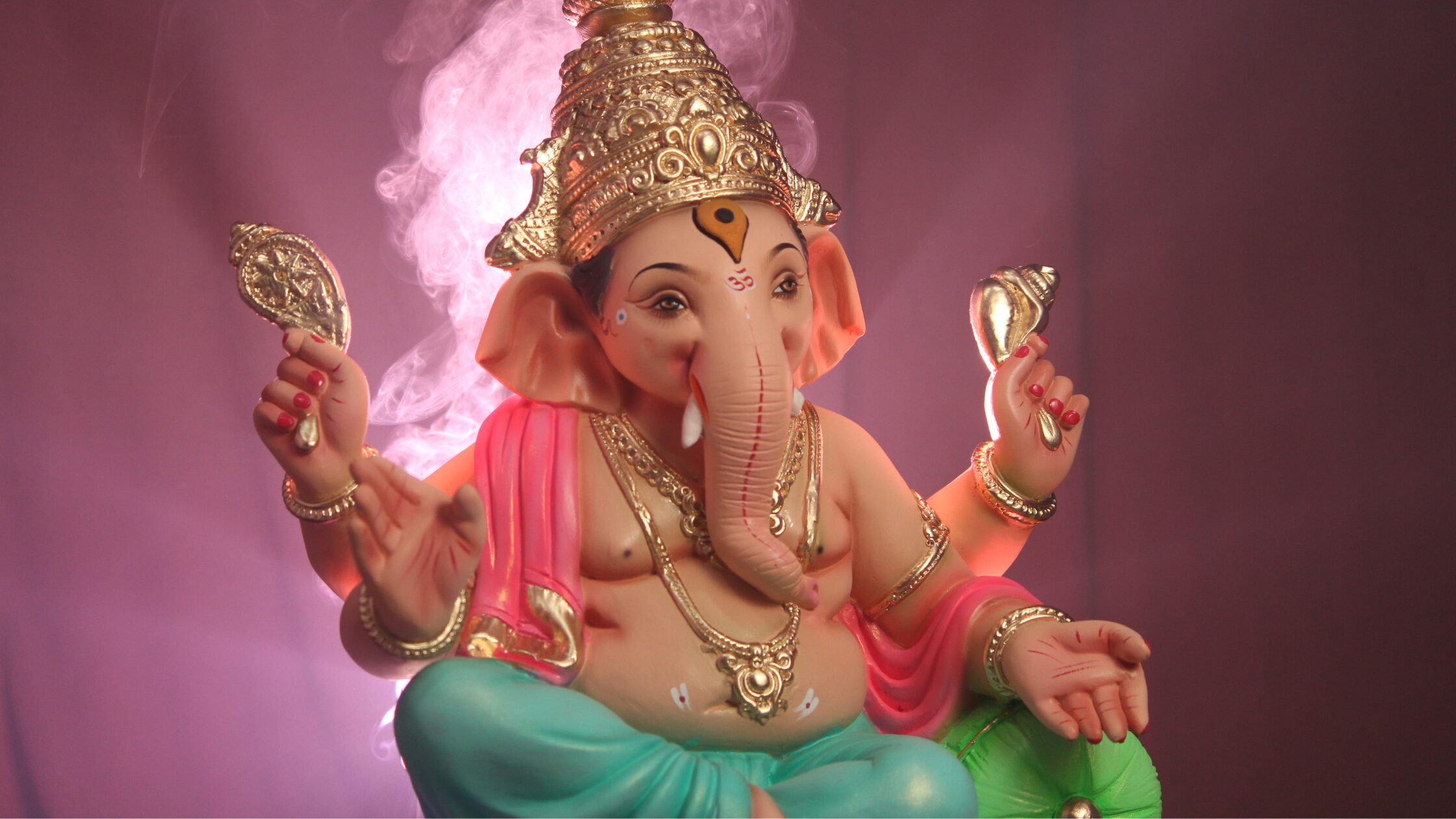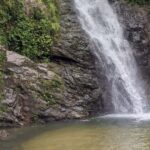Sri Siva Subramaniya Temple is the largest Hindu temple in the southern hemisphere and it is awesome. The most impressive sight in the temple are the ceiling paintings and murals but since you’re not allowed to take pictures inside we can’t show them to you here. If you show up with bare legs (i.e. you’re wearing shorts), you’ll be offered a sarong/sulu at the entrance so as to meet the dress requirements. Now let’s dive in to what you need to know about Nadi’s number one cultural attraction!
Sri Siva Subramaniya Temple Location
The temple is a 12 minute drive south from Nadi’s centre along Queens Road, but you can take an alternate route along Nadi Back Road if you want a bit more scenery along the way. Here’s the Google Maps location:
Overview of Sri Siva Subramaniya Temple
As you explore Nadi, a city on the western side of Fiji, one of the most remarkable landmarks that catches your eye is the Sri Siva Subramaniya Temple. This is not just a place of worship but also a standout attraction due to its notable features and cultural significance.
Architectural Design
The temple is an iconic example of traditional Dravidian architecture, distinguished by its vividly coloured façade and ornate decorations. When you step closer, you’ll notice the detailed carvings and statues depicting Hindu deities, warriors, and spiritual stories that adorn the structure.
Cultural Hub
As the largest Hindu temple in the Southern Hemisphere, this spiritual complex serves as a testament to the multicultural fabric of Fiji, symbolising a place where different ethnicities and traditions harmoniously coexist.
Etiquette and Access
Appreciating the sacred nature of the site is vital. You are expected to adhere to cultural etiquette by covering your legs and shoulders. While the temple is available to visitors almost daily, adherence to visiting hours and respect for Hindu practices is paramount.
Spiritual Significance
For adherents of Hinduism, this temple is more than an architectural marvel; it’s a profound place of spirituality and devotion, dedicated to the deity Subramaniya.
In a nutshell, a visit to the Sri Siva Subramaniya Temple offers a blend of spiritual insight, cultural experience, and architectural splendour, making it a must-visit destination on your Fijian itinerary.
Architectural Significance
Embarking on a journey to understand the Sri Siva Subramaniya Temple, you’ll uncover a wealth of traditional Dravidian architecture. This temple, built in 1986, is a testament to ancient design principles and striking use of color, which is characteristic of southern Indian Hindu temples.
Dravidian Architecture
The temple’s design is a significant reflection of Dravidian architecture, a style that has been prevalent in South India for centuries. Your attention will likely be captured by the towering gopuram, a monumental tower teeming with intricate carvings and vibrant hues. Not only does this architecture provide an awe-inspiring visual display, but it also serves a spiritual purpose, drawing the eye upward and inspiring contemplation.
Statues and Artwork
As you explore further, you’ll encounter an array of statues and artwork that enrich the temple’s spiritual ambiance. Painstakingly crafted by skilled artisans, these statues represent deities revered in Hinduism. The meticulous craftsmanship is evident in every aspect, from the lifelike expressions to the detailed adornments. The temple’s interior is equally adorned with colorful paintings and artifacts, each contributing to the narrative of Hindu mythology and Sri Siva Subramaniya’s significance.
Cultural and Spiritual Relevance
The Sri Siva Subramaniya Swami Temple in Fiji is not only an architectural marvel but also a nexus of spiritual energy and cultural tradition. Here, you will witness the seamless blend of culture and divinity that defines the Hindu way of life.
Deities and Shrines
At the heart of the temple lies the dedication to Lord Murugan, the son of Lord Shiva and Goddess Parvati, revered as the deity of youth, power, and virtue. This temple is unique as it represents traditional Dravidian architecture, which is rarely found outside India. Lord Murugan’s vibrantly decorated shrine is the centrepiece, inviting you to immerse yourself in prayer and worship, enhancing your spiritual experience.
- Shiva – The presiding deity of the complex, Lord Shiva embodies the essence of destruction and re-creation, pivotal to Hinduism’s cosmic cycle. His presence in the temple offers a profound sense of connection to the eternal.
Rituals and Practices
The temple pulsates with life during the performance of Puja, a form of worship through which reverence is offered to the deities. The rituals here follow ancient traditions and are observed with strict adherence, providing a window into the sanctity of Hindu customs.
Festivals: Your visit may coincide with colourful and vibrant festivals, where rituals transform into large-scale celebrations, each offering a unique aspect of the deities. Witness the congregation of devotees during these auspicious times, where the air is filled with chants and the energy of fellowship strengthens the community’s bond.
Daily Rituals: Engage in daily prayer services, which occur several times and involve offerings and recitations that encourage reflection and inner peace. These practices are integral to maintaining the temple’s sacred atmosphere and allowing for a full spiritual experience.
- Witnessing or participating in these customs will give you a deeper understanding of the cultural fabric that makes the Sri Siva Subramaniya Swami Temple a beacon of worship and collective Hindu identity in the Pacific.
Visiting the Temple
When you visit the Sri Siva Subramaniya Swami Temple in Nadi Town, expect to witness a spectacular example of traditional Dravidian architecture—the largest of its kind in the Southern Hemisphere. It’s both a spiritual haven and a cultural experience where you can partake in guided tours to enrich your understanding.
What to Expect
At Sri Siva Subramaniya Temple, you’ll be greeted by vivid colours and intricate carvings, embodying centuries-old craftsmanship. Remember to dress modestly as a sign of respect for the spiritual environment. You’ll have the opportunity to observe devotees offering prayers and to participate in ritualistic ceremonies if you choose. Photography is allowed, but it should be done discreetly and with permission where required.
Guided Tours and Experiences
To deepen your appreciation, opt for a guided tour available for a small fee. This not only allows you to learn about the temple’s history and the significance of its many statues and carvings, but it also gives you a chance to interact with temple officials and ask questions. These tours offer a structured approach to temple visitation, ensuring you have a holistic experience.
Dining and Shopping Nearby
Your visit won’t be complete without exploring the shops and restaurants just a stone’s throw from the temple. Tantalise your taste buds with local Fijian cuisine at nearby eateries or enjoy Indian dishes akin to the temple’s heritage. Look for souvenirs as well, as the surrounding shops offer a range of items, from spiritual artefacts to local crafts, perfect for remembering your experience by or taking home to your loved ones.
Etiquette and Respect
When visiting the Sri Siva Subramaniya Swami Temple, it’s imperative that you adhere to the cultural norms to show respect for the religious practices and mythology that underpin this sacred place.
Attire: Dress conservatively. It’s required that you cover your shoulders and knees. A sarong is often worn by visitors—if you don’t have one, it’s usually possible to rent or borrow one at the temple.
Footwear: You must remove your shoes before entering the temple sanctum. This is a sign of respect and helps keep the interior clean.
Photography: Ask for permission before taking photos, especially inside the temple. Photography may be prohibited in certain areas to maintain the sanctity of the sanctuary.
Conduct:
- Speak in a quiet voice while you’re within temple premises.
- Avoid any form of public display of affection as it’s considered disrespectful.
Sacred Areas:
- Certain areas of the temple may be off-limits. These are typically reserved for religious functions or for use by the priests alone.
- The inner sanctum is the most sacred area, and access may be restricted. Follow any posted signs and instructions from temple staff.
By following these guidelines, you contribute to the temple’s atmosphere of reverence and ensure a respectful experience for yourself and others.
Events and Celebrations
When you visit the Sri Siva Subramaniya Swami Temple in Fiji, you’ll find yourself immersed in an array of vibrant events and celebrations that showcase the heritage and religious traditions of Hindu culture.
Festivals: This temple is a focal point for Hindu festivals, with Maha Shivaratri being one of the prominent celebrations honouring Lord Shiva. Expect to see the temple bustling with devout worshippers engaging in rituals and prayers. Festive music fills the air, while the scent of incense wafts through the colourful corridors.
Diwali, the Festival of Lights, is another joyous time at the temple. During this festival, the temple is adorned with countless lamps and lights, creating a mesmerising environment that reflects the triumph of good over evil, light over darkness.
Cultural Heritage: Special occasions often feature classical music and dance performances that pay tribute to Indian heritage. You can experience the intricate movements of Bharatanatyam dancers and savour the complex rhythms of traditional music.
Culinary Delights: Food plays an integral role in celebrations, and you’re likely to encounter a variety of vegetarian dishes that are not only symbolic but also a treat for your taste buds.
Here is a quick glance at what you might experience during major events:
| Festivals | Activities | Cultural Elements |
|---|---|---|
| Maha Shivaratri | Prayer, fasting, night-long vigils | Sacred chants, spiritual ambience |
| Diwali | Lighting of lamps, fireworks display | Sweets distribution, joyous rituals |
Remember to dress modestly and follow temple etiquette to fully appreciate the spiritual and cultural richness of these celebrations.
Location and Accessibility
The Sri Siva Subramaniya Swami Temple, a significant landmark in the Pacific, is readily accessible in Nadi, Fiji. It stands as a hub for spirituality and culture, inviting you to explore its vibrant colours and serene atmosphere.
Getting There
Reaching the Sri Siva Subramaniya Swami Temple is straightforward, given its location at the southern end of Nadi’s main street, Queens Road. If you’re arriving via Nadi International Airport, a short drive will get you to this majestic temple. Taxis and local buses regularly service the route, providing you with multiple transport options. When planning your visit, note that travel times may vary during peak hours due to traffic in Nadi town.
Temple Grounds and Amenities
Once you arrive, you’ll find modest parking facilities available. Remember to dress respectfully when visiting the temple. Cover your legs and shoulders to adhere to traditional Hindu etiquette, with sarongs available at the entrance if needed. Inside, the temple grounds are a peaceful retreat where you can meditate and enjoy the tranquillity of the gardens. To support your visit, the temple offers amenities like washrooms and a small shop for souvenirs and refreshments. The site is equipped to welcome guests from sunrise to sunset, although it closes for a few hours in the early afternoon.
Engaging with Local Culture
When you visit the Sri Siva Subramaniya Temple in Fiji, immerse yourself in the rich tapestry of Fijian-Indian heritage. Engaging with the local culture here is an enriching experience that involves appreciating traditional crafts and participating in cultural exchanges.
Craftsmen and Artisans
The Sri Siva Subramaniya Temple is not just a spiritual hub; it’s a vibrant showcase of craftsmanship. Local artisans demonstrate age-old skills that have been passed down through generations. You can observe intricate temple carvings that echo Dravidian architecture, a style originating from South India. During your visit, make sure to allocate time for shopping at the temple’s nearby market, where you can purchase handcrafted souvenirs that support the local economy.
Cultural Exchanges
Your time in Nadi is greatly enhanced by cultural exchanges that provide insight into the blended heritage of this unique region. Participate in a cultural workshop or a guided tour, where you can learn about traditional customs and the history of Indian migration to Fiji. Dining at local restaurants allows you to savour the fusion of Indian and Pacific Islander cuisine, an encounter that’s both delightful for the palate and enlightening for your understanding of Fiji’s diverse cultural landscape.
Frequently Asked Questions
In this section, you’ll find detailed answers to common questions about the Sri Siva Subramaniya Swami Temple, ensuring a respectful and enriching visit.
What are the visiting hours for the Sri Siva Subramaniya Swami Temple in Fiji?
The temple is open to the public daily from sunrise to sunset, although it is closed for a few hours in the early afternoon. Make sure to check for any specific timings before you plan your visit.
What cultural significance does the Sri Siva Subramaniya Swami Temple hold in Fiji?
As a beacon of unity, the Sri Siva Subramaniya Swami Temple represents Fiji’s multicultural spirit. The temple serves not only as a place of worship but also as a gathering space where different cultures harmonise.
Are there any dress codes or behavioural protocols to observe when visiting the Sri Siva Subramaniya Swami Temple?
Yes, you are expected to adhere to a dress code which entails covering your legs and shoulders. Behave respectfully, as this is a place of reverence for many.
What architectural style is the Sri Siva Subramaniya Swami Temple built in, and what are its main features?
This temple is an example of Dravidian architecture, with pyramid-shaped towers and intricate carvings representing warriors, kings, and gods that adorn the structure.
Can non-Hindu visitors enter the Sri Siva Subramaniya Swami Temple, and what should they expect?
Non-Hindu visitors are welcomed to the temple. You should expect to experience a spiritual environment with traditional rituals and ceremonies forming part of the daily practice.
What events or festivals are associated with the Sri Siva Subramaniya Swami Temple, and when do they take place?
The temple is central to many Hindu festivals, with various celebrations occurring throughout the year. Timing for these festivals varies, so it’s best to check in advance for any events during your visit.





